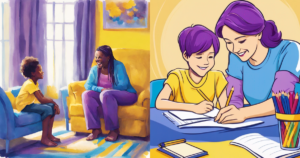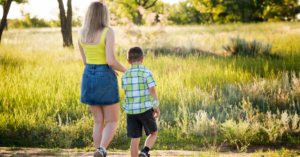School shootings are scary, heartbreaking, and confusing, to say the least. They can even stir up all sorts of unexpected emotions for those who were not directly involved in it.
During times like these, our world gets very small, and we can feel the enormity of the emotions which are taking place.
As parents, it is important to check in with our school-aged children to see how they are doing.
For children that are teenagers or have their own access to social media, it is best to start by asking them what they have already heard and how they feel about what they have heard, then go from there.
For younger school-aged children, it is important to let them know that something has happened and explain it in an age-appropriate way. It’s best to keep it short and factual. The goal is that if they hear about this from someone else, they will not be surprised and they will feel safe coming to you with their questions and concerns.
For example, you could say: “I wanted to let you know that a school shooting took place today at a high school in Georgia. Did you hear about this already?
If they already heard about it, ask them what they know and what their thoughts and feelings are about it.
If they did not hear about it, you can say: “I wanted you to hear this from me so you wouldn’t be surprised if you hear someone talking about it. I also wanted you to know that I am here for you and that you can ask me any questions.”
When questions come up, just focus on answering their exact questions and checking in with them to find out what they think or feel about it. And, if they are not sure what they think or feel, that’s okay, too. You can check back in with them later.
Since our children pick up on our emotions and energy, it is important to check in in terms of how we are feeling about what has happened and then work to process some of those emotions, if possible, first.
It’s also helpful to set an intention prior to speaking with our children and then to center ourselves with a few slow, deep breaths, at least 3, and place your hand over your heart, prayer position, or open palms up as you do so. This is more about managing our emotions and energy so that it does not get in the way of having a meaningful conversation with our child.
And, if emotions come up for you, that is okay because it shows that you care. If you become uncontrollably upset speaking about this, it may be a good idea to take a timeout from the conversation so you can honor your emotions. You can say something like this:
“Wow, I did not realize I would be feeling this upset right now about what happened. I would like to take a time out so I can honor my emotions. I’ll get back with you in xx time so we can talk more. Don’t worry. I’ll be fine. This is just part of the process.” And then make sure to come back within that time frame to resume the conversation.
Depending on what works for you, you could go for a walk, do some emotional release writing or just have a really, big cry. There are many options to honor our emotions. And, these options can work for our children, too.
The following are more tips and strategies for you to consider using after a school shooting:
Create a Safe Space for Communication:
• Listen Actively: It’s important to allow our children to express their feelings and fears. Listen to them without interrupting or dismissing their emotions.
• Answer Questions Honestly: Provide age-appropriate information and avoid speculation. Be truthful but try to maintain a sense of safety and security.
• Normalize their Feelings: Let them know that it is perfectly natural to feel upset or scared.
Reassure Safety:
• Highlight Protective Measures: Explain the safety measures the school and local authorities have in place to keep them safe, if you know them.
• Stay Calm: Our demeanor will influence our child’s feelings. Staying calm and composed can provide a sense of stability.
Monitor Emotional Responses:
• Watch for Changes: Pay attention to changes in behavior, appetite, and sleeping patterns. These could be signs of stress or anxiety.
• Encourage Expression: Promote open discussions or other forms of expression, such as drawing or writing, to help them process their emotions.
Limit Media Exposure:
• Reduce Exposure: Continuous media coverage can increase fear and anxiety. Limit exposure to news broadcasts and social media.
• Discuss What They See: When they do see media reports, discuss them together to put the information in context and dispel any misconceptions.
Maintain Routine:
• Consistency is Key: Keeping a regular routine can provide a sense of normalcy and security.
• Incorporate Fun Activities: Ensuring that our children continue to engage in activities they enjoy can help reduce stress.
Be Available:
• Quality Time: Spending quality time with our children help them feel loved and supported.
• Reach Out for Help: If we notice our child’s anxiety persists, consider seeking help from a mental health professional.
Empower Them:
• Problem-Solving Skills: Teaching our children techniques for managing stress and identifying ways to stay safe, can help put their minds at ease.
• Areas of Control: By helping our children understand what they DO have control over can help reduce stress and anxiety. Our children can take a piece of paper and write or draw out what they do have control over.











